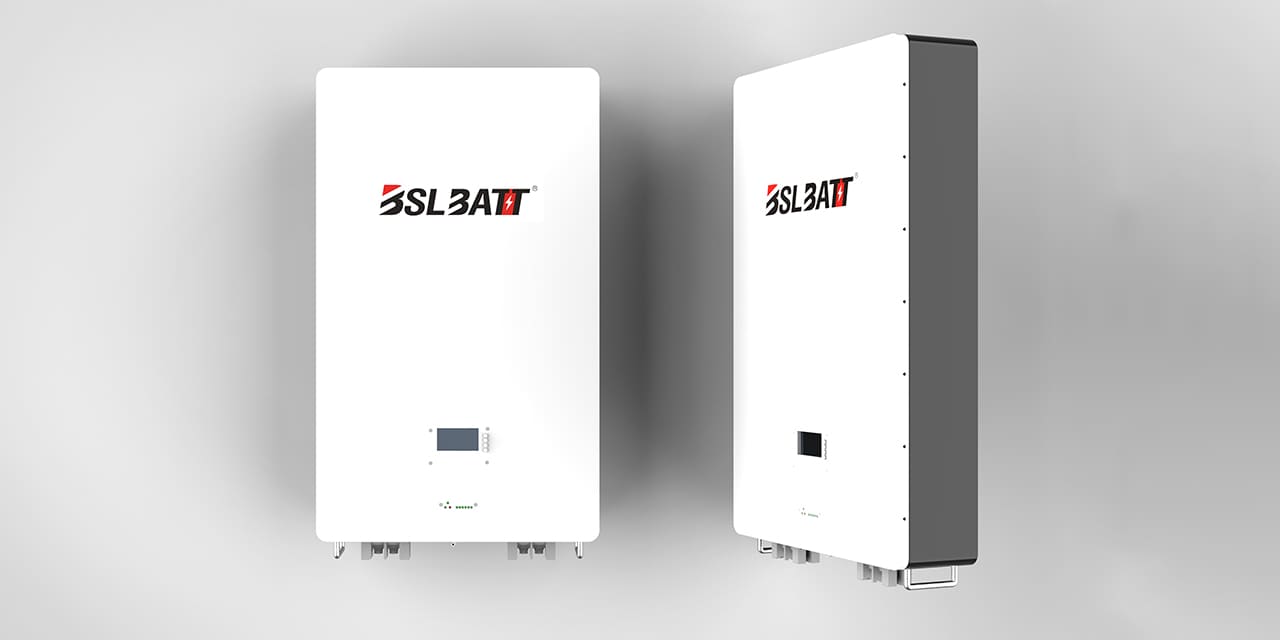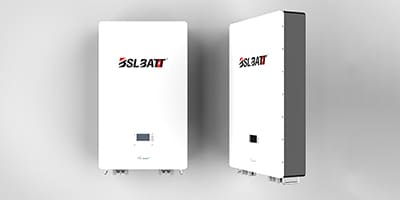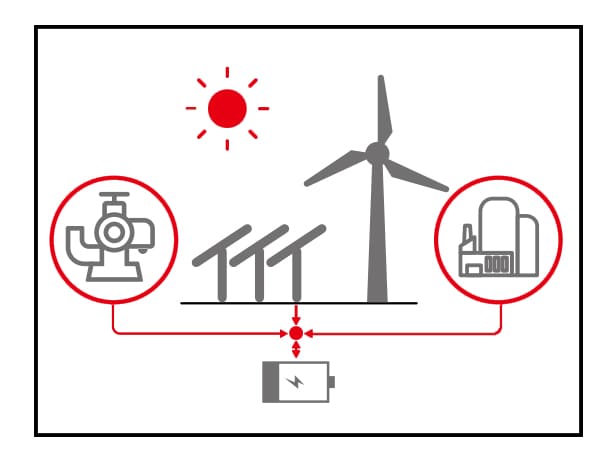At present, in the field of house battery storage, the mainstream batteries are lithium-ion batteries and lead-acid batteries. In the early stage of energy storage development, it was difficult to achieve large-scale applications due to the technology and cost of lithium-ion batteries. At present, with the improvement of the maturity of lithium-ion battery technology, the decline in the cost of large-scale manufacturing and policy-oriented factors, lithium-ion batteries in the field of house battery storage have greatly exceeded the application of lead-acid batteries. Of course, product attributes also need to match the character of the market. In some markets where cost performance is outstanding, the demand for lead-acid batteries is also strong. Choosing li ion solar batteries as your house battery storage systems Lithium-ion batteries have some characteristics compared to lead-acid batteries, as follows. 1. lithium battery energy density is greater, lead-acid battery 30WH/KG, lithium battery 110WH/KG. 2. lithium battery cycle life is longer, lead-acid batteries on average 300-500 times, lithium batteries up to more than a thousand times. 3. the nominal voltage is different: single lead-acid battery 2.0 V, single lithium battery 3.6 V or so, lithium-ion batteries are easier to connect in series and parallel to get different lithium battery banks for different projects. 4. the same capacity, volume and weight are smaller lithium batteries. Lithium battery volume is 30% smaller, and the weight is only one-third to one-fifth of lead acid. 5. lithium-ion is the currently safer application, there is a BMS unified management of all lithium battery banks. 6. lithium-ion is more expensive, 5-6 times more expensive than lead-acid. House solar battery storage important parameters At present, the conventional house battery storage has two kinds of high-voltage battery as well as low-voltage batteries, and the parameters of the battery system are closely related to the battery selection, which need to be considered from the installation, electrical, safety and usage environment. The following is an example of BSLBATT low-voltage battery and introduces the parameters that need to be noted in the selection of house batteries.  Installation parameters (1) weight / length, width and height (weight / dimensions) Need to consider the ground or wall load-bearing according to different installation methods, and whether the installation conditions are met. Need to consider the available installation space, house battery storage system whether the length, width and height will be limited in this space. 2)Installation method (installation) How to install at the customer’s site, the difficulty of installation, such as floor/wall mounting. 3)Protection degree The highest level of waterproof and dustproof. The higher protection degree means that the home lithium battery can support outdoor use. Electrical parameters 1) Usable energy The maximum sustainable output energy of house battery storage systems is related to the rated energy of the system and the depth of discharge of the system. 2) Operating voltage range (operating voltage) This voltage range needs to match with the battery input battery range at the inverter end, high voltage or lower than the battery voltage range at the inverter end will cause the battery system can not be used with the inverter. 3) Maximum sustained charge/discharge current (maximum charge/discharge current) The lithium battery system for home supports the maximum charge/discharge current, which determines how long the battery can be fully charged, and this current will be limited by the maximum current output capacity of the inverter port. 4) Rated power (rated power) With the rated power of the battery system, the best choice of power can support the inverter full load charging and discharging power. Safety parameters 1) Cell type (cell type) Mainstream cells are lithium iron phosphate (LFP) and nickel cobalt manganese ternary (NCM). BSLBATT house battery storage is currently using lithium iron phosphate cells. 2) Warranty Battery warranty terms, warranty years and scope,BSLBATT offers its customers two options, a 5-year warranty or a 10-year warranty. Environmental parameters 1) Operating temperature BSLBATT solar wall battery supports the charging temperature range of 0-50℃ and the discharging temperature range of -20-50℃. 2) Humidity/altitude The maximum humidity range and altitude range that the house battery system can withstand. Some humid or high-altitude areas need to pay attention to such parameters. How to choose a home lithium battery capacity? Choosing the capacity of a home lithium battery is a complex process. In addition to the load, many other factors need to be considered, such as the battery charging and discharging capacity, the maximum power of the energy storage machine, the power consumption period of the load, the actual maximum discharge of the battery, the specific application scenario, etc., to choose the battery capacity more reasonably. 1) Determine the inverter power according to the load and PV size Calculate all the loads and PV system power to determine the inverter size. It should be noted that sectoral inductive/capacitive loads will have a large starting current when starting, and the maximum instantaneous power of the inverter needs to cover these powers. 2) Calculate the average daily power consumption Multiply the power of each device by the operating time to get the daily power consumption. 3) Determine the actual battery demand according to the scenario Deciding how much energy you want to store in the Li-ion battery pack has a very strong relationship with your actual application scenario. 4) Determine the battery system The number of batteries * rated energy * DOD = available energy, also needs to take into account the output capacity of the inverter, the appropriate margin design. Note: In home energy storage system, you also need to consider the efficiency of the PV side, the efficiency of the energy storage machine, and the charging and discharging efficiency of the lithium solar battery bank to determine the most appropriate module and inverter power range. What are the applications of house battery systems? There are many application scenarios, such as self-generation (high electricity cost or no subsidy), peak and valley tariff, backup power (unstable grid or important load), pure off-grid application, etc. Each scenario requires different considerations. Here we analyze “self-generation” and “standby power” as examples. Self-generation In a certain region, due to high electricity prices or low or no subsidies for grid-connected PV (the cost of electricity is lower than the cost of electricity). The main purpose of installing PV energy storage system is to reduce the electricity consumption from the grid and reduce the electricity bill.
Installation parameters (1) weight / length, width and height (weight / dimensions) Need to consider the ground or wall load-bearing according to different installation methods, and whether the installation conditions are met. Need to consider the available installation space, house battery storage system whether the length, width and height will be limited in this space. 2)Installation method (installation) How to install at the customer’s site, the difficulty of installation, such as floor/wall mounting. 3)Protection degree The highest level of waterproof and dustproof. The higher protection degree means that the home lithium battery can support outdoor use. Electrical parameters 1) Usable energy The maximum sustainable output energy of house battery storage systems is related to the rated energy of the system and the depth of discharge of the system. 2) Operating voltage range (operating voltage) This voltage range needs to match with the battery input battery range at the inverter end, high voltage or lower than the battery voltage range at the inverter end will cause the battery system can not be used with the inverter. 3) Maximum sustained charge/discharge current (maximum charge/discharge current) The lithium battery system for home supports the maximum charge/discharge current, which determines how long the battery can be fully charged, and this current will be limited by the maximum current output capacity of the inverter port. 4) Rated power (rated power) With the rated power of the battery system, the best choice of power can support the inverter full load charging and discharging power. Safety parameters 1) Cell type (cell type) Mainstream cells are lithium iron phosphate (LFP) and nickel cobalt manganese ternary (NCM). BSLBATT house battery storage is currently using lithium iron phosphate cells. 2) Warranty Battery warranty terms, warranty years and scope,BSLBATT offers its customers two options, a 5-year warranty or a 10-year warranty. Environmental parameters 1) Operating temperature BSLBATT solar wall battery supports the charging temperature range of 0-50℃ and the discharging temperature range of -20-50℃. 2) Humidity/altitude The maximum humidity range and altitude range that the house battery system can withstand. Some humid or high-altitude areas need to pay attention to such parameters. How to choose a home lithium battery capacity? Choosing the capacity of a home lithium battery is a complex process. In addition to the load, many other factors need to be considered, such as the battery charging and discharging capacity, the maximum power of the energy storage machine, the power consumption period of the load, the actual maximum discharge of the battery, the specific application scenario, etc., to choose the battery capacity more reasonably. 1) Determine the inverter power according to the load and PV size Calculate all the loads and PV system power to determine the inverter size. It should be noted that sectoral inductive/capacitive loads will have a large starting current when starting, and the maximum instantaneous power of the inverter needs to cover these powers. 2) Calculate the average daily power consumption Multiply the power of each device by the operating time to get the daily power consumption. 3) Determine the actual battery demand according to the scenario Deciding how much energy you want to store in the Li-ion battery pack has a very strong relationship with your actual application scenario. 4) Determine the battery system The number of batteries * rated energy * DOD = available energy, also needs to take into account the output capacity of the inverter, the appropriate margin design. Note: In home energy storage system, you also need to consider the efficiency of the PV side, the efficiency of the energy storage machine, and the charging and discharging efficiency of the lithium solar battery bank to determine the most appropriate module and inverter power range. What are the applications of house battery systems? There are many application scenarios, such as self-generation (high electricity cost or no subsidy), peak and valley tariff, backup power (unstable grid or important load), pure off-grid application, etc. Each scenario requires different considerations. Here we analyze “self-generation” and “standby power” as examples. Self-generation In a certain region, due to high electricity prices or low or no subsidies for grid-connected PV (the cost of electricity is lower than the cost of electricity). The main purpose of installing PV energy storage system is to reduce the electricity consumption from the grid and reduce the electricity bill.  Application scenario characteristics: a. Off-grid operation is not considered (grid stability) b. Photovoltaic only to reduce electricity consumption from the grid (higher electricity bills) c. Generally there is sufficient light during the day We consider the input cost and electricity consumption, we can choose to choose the capacity of household battery storage according to the average daily household electricity consumption (kWh) (the default PV system is sufficient energy). The design logic is as follows:
Application scenario characteristics: a. Off-grid operation is not considered (grid stability) b. Photovoltaic only to reduce electricity consumption from the grid (higher electricity bills) c. Generally there is sufficient light during the day We consider the input cost and electricity consumption, we can choose to choose the capacity of household battery storage according to the average daily household electricity consumption (kWh) (the default PV system is sufficient energy). The design logic is as follows:  This design theoretically achieves PV power generation ≥ load power consumption. However, in the actual application, it is difficult to achieve perfect symmetry between the two, considering the irregularity of load power consumption and the parabolic characteristics of PV power generation and weather conditions. We can only say that the power supply capacity of PV + house solar battery storage is ≥ load electricity consumption. house battery backup power supply This type of application is mainly used in areas with unstable power grids or in situations where there are important loads.
This design theoretically achieves PV power generation ≥ load power consumption. However, in the actual application, it is difficult to achieve perfect symmetry between the two, considering the irregularity of load power consumption and the parabolic characteristics of PV power generation and weather conditions. We can only say that the power supply capacity of PV + house solar battery storage is ≥ load electricity consumption. house battery backup power supply This type of application is mainly used in areas with unstable power grids or in situations where there are important loads.  Application scenarios are characterized by a. Unstable power grid b. Critical equipment cannot be disconnected c. Knowing the power consumption and off-grid time of the equipment when off-grid In a sanatorium in Southeast Asia, there is an important oxygen supply machine that needs to work 24 hours a day. The power of the oxygen supply machine is 2.2kW, and now we have received a notice from the grid company that the power needs to be disconnected for 4 hours a day from tomorrow due to the grid renovation. In this scenario, the oxygen concentrator is an important load, and the total power consumption and the expected time of off-grid are the most critical parameters. Taking the maximum expected time of 4 hours for the power outage, the design idea can be referred to.
Application scenarios are characterized by a. Unstable power grid b. Critical equipment cannot be disconnected c. Knowing the power consumption and off-grid time of the equipment when off-grid In a sanatorium in Southeast Asia, there is an important oxygen supply machine that needs to work 24 hours a day. The power of the oxygen supply machine is 2.2kW, and now we have received a notice from the grid company that the power needs to be disconnected for 4 hours a day from tomorrow due to the grid renovation. In this scenario, the oxygen concentrator is an important load, and the total power consumption and the expected time of off-grid are the most critical parameters. Taking the maximum expected time of 4 hours for the power outage, the design idea can be referred to.  Comprehensive above two cases, the design ideas are relatively close, what needs to be considered is the different requirements of specific application scenarios, the need to select the most suitable house for their own after specific analysis of specific application scenarios, battery charging and discharging capacity, the maximum power of the storage machine, the load’s power consumption time, and the actual maximum discharge of the solar lithium battery bank battery storage system.
Comprehensive above two cases, the design ideas are relatively close, what needs to be considered is the different requirements of specific application scenarios, the need to select the most suitable house for their own after specific analysis of specific application scenarios, battery charging and discharging capacity, the maximum power of the storage machine, the load’s power consumption time, and the actual maximum discharge of the solar lithium battery bank battery storage system.
Post time: May-08-2024








